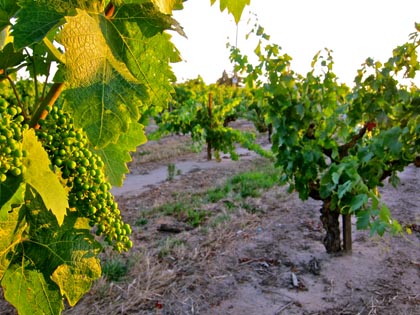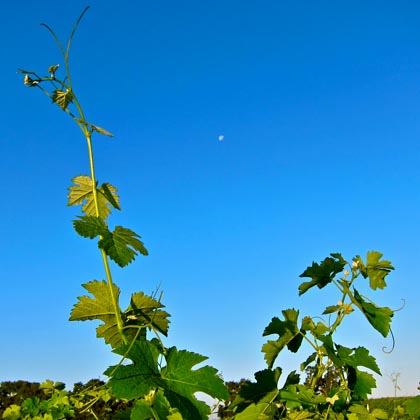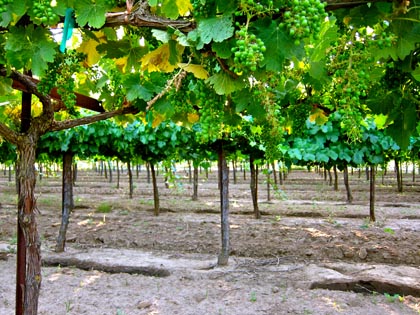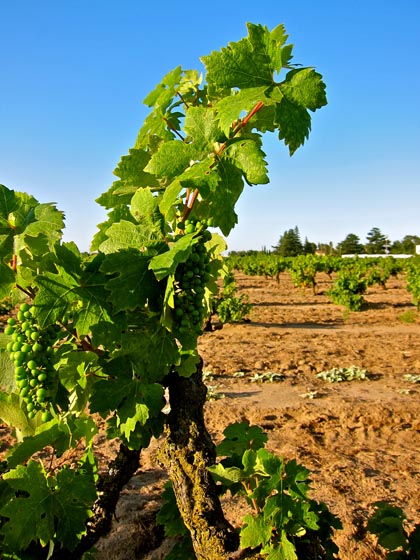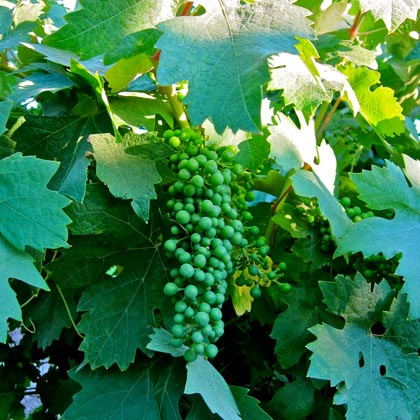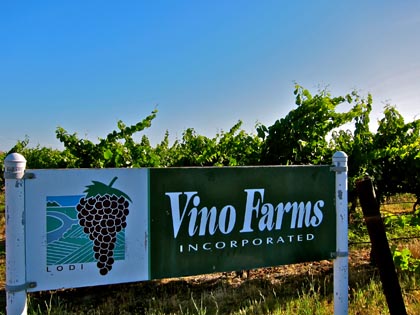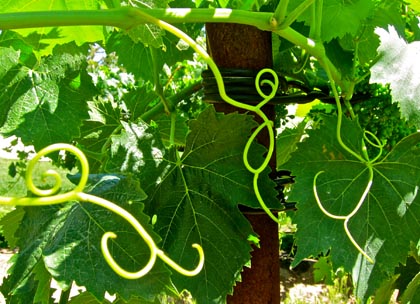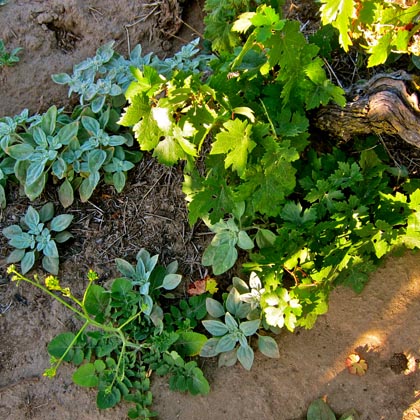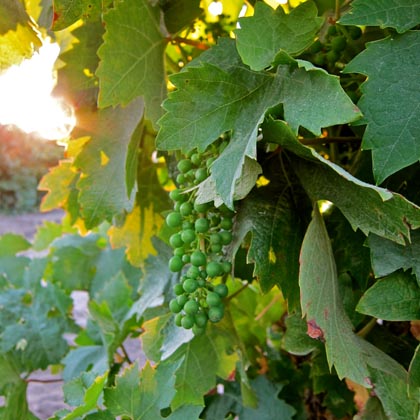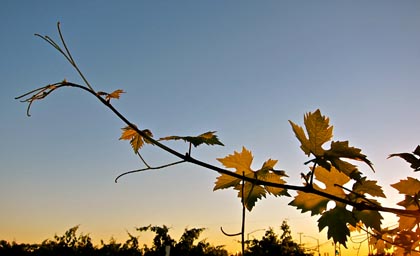Letters from Lodi
An insightful and objective look at viticulture and winemaking from the Lodi
Appellation and the growers and vintners behind these crafts. Told from the
perspective of multi-award winning wine journalist, Randy Caparoso.
Update on 2011 Lodi wine crop
Lodi sunset, June 2011: ancient Alicante Bouschet at Mohr-Fry Ranches
The real scoop, straight from the source…
First things first: never believe everything you read, especially if you’re like most people when it comes to news reports – you only read the headlines and scan for the sensational words.
Tendrils reaching for the lingering morning moon in Bokisch's Clements Hills AVA vineyard
California grape growers suffer a sobering spring, was the title of the Associated Press release printed in newspapers across the country earlier in the month (June 10), with doomsday phraseology pouring down like hard rain: “killer snow… hard freeze… dry-season downpours… sleepless nights… late precipitation… mildew…” and an accompanying photo taken of Tablas Creek Vineyard in Paso Robles on June 6, the caption reading how an all-night freeze “wiped out an entire crop.”
Why don’t they just declare California’s 2011 wine crop a vinous Rapture already, and let all these poor, doomed growers and winemakers shuffle off their mortal coils?
Here’s the hard, cold reality: California’s 2011 wine crop is not headed for a wipeout – probably not even close, because the opposite is more likely – and there is no indication that this $18.5 billion industry is in any danger of veering off course. Not the way we’re drinking ‘em, and certainly not the way they’re growing ‘em. California winegrowers have a history, in fact, of successfully dealing with Mother Nature’s slings and arrows, and they get better at it every year.
Secondly: California is a mighty big state. Heck, Paso Robles is big enough in itself that if one grower loses a third of his crop to mildew pressure, ten other growers within the same square mile, who were not caught quite so unaware or whose vineyards are located more fortuitously, may very well not lose a single ton.
Forest of vines supplying Kautz's Ironstone Symphony
Lodi is a mighty big wine region. If you ate up what the press reported from last year, you might have assumed that Lodi’s 2010 harvest was the worse in history; when in fact, it was quite possibly Lodi’s absolute finest. Try finding a Lodi grower or winemaker who might disagree with that. You won’t.
Dry farming and super-sandy loam yields miniscule zin clusters in this 90+ year old Mokelumne River AVA vineyard
Even if the cold spring and sluggish summer in 2010 gave winegrowers white hairs throughout the rest of California, in the end nearly everyone was very satisfied with the quality of the grapes and impending wines, despite the numerous doomsday forecasts. Many of the top artisanal winemakers in, say, Napa Valley and Sonoma County are already saying that they made some of their finest wines ever in 2010.
In respect to industry wide revenue: sure, the 2010 harvest in California was down about 12% overall from the previous year. But what the stories don’t tell you was that in 2009 the crop was probably about 12% too high (second highest in California history, in fact), as a good percentage of grapes went unsold, sold for paltry prices, or else left in the fields unpicked. Besides, as everyone knows, quantity never equals quality either.
So if you really want to know how the 2011 winegrowing season in Lodi is coming along thus far, then you need to hear it from the source: some of our key growers and winemakers. Without any further, or sensationalized, ado, their extremely bright prognostications…
Bruce Fry of Mohr-Fry Ranches:
Weather makes farming interesting. It is never the same, day to day or year to year. It is amazing what weather does to the vines, and this year is no exception. We have had a cooler spring than last year, and last year was cold! So the vines are growing slower and the bunches are elongated.
During bloom we had rain and cool weather, which might translate to a looser bunch and lighter crop than normal, and maybe bigger berries. We have had over .75” of rain in June, and yesterday (June 15) it was 94 degrees. I have been hearing and seeing that there is some mildew around the Lodi area but haven’t heard of botrytis yet. When all is said and done, I think it will be another great year in Lodi. You have to love this – Mother Nature keeps you on your toes, and you have to figure out what she might do next!
104 year old James Ranch vine, sourced by DFV for Gnarly Head zin
Bud Bradley of DFV Wines (Delicato Family Vineyards):
At this point I would say Lodi is headed for a slightly smaller crop and a harvest about two weeks later than normal, if there is such a thing. After a very cool, wet winter and spring, I haven’t seen the vines looking so good in years. The only problem I see is slowing down the shoot growth and getting the vines to start maturing crop; which is just starting, although a little late. If the weather holds up and we have a nice late summer and fall, I think it will be a year to remember. Although almost every year in Lodi is a good one, this may be a “vintage” year.
In mid-June, Bokisch’s Clements Hills Merlot maturing berries just between BB and marble size
Joe Valente of John Kautz Farms:
A large percentage of the growers in the Lodi area have been farming in the area for generations. They fully understand the effect of the weather on their crops. We may not have any control over the challenges that we face during the growing season, but all signals are towards a later than normal harvest in 2011.
Markus Bokisch of Bokisch Vineyards:
While the 2011 spring has presented Lodi wine growers with unique challenges due to incessant rain and cool weather, the season is setting itself up to be another stellar vintage. The cool, overcast, breezy weather has lead to lush canopy growth in our vineyards. The recently arrived heat has woken up the vines with tendrils reaching to the sky in a way I have never before experienced. Soon the vines will be tamed into a slower growth pattern as they start developing their fruit. This cooler pattern, which resembles last year, will lead to intense color extraction, excellent balanced acidity, and silky tannins due to long-hang time. However, the hang time will not lead to high alcohol because of the cool season.
This season, as in last year’s, only proves once again that the Lodi region is ideally suited to wine grapes. For over 100 years, Lodi has been able to sustain year after year of quality wine production. 2011 may very well prove to be one of our best.
June 19,2011:this Zinfandel cluster looking real good at the old "Clancey Ranch" (117 years!) in the Mokelumne River AVA's eastside, shared by Klinker Brick and Heritage Oak
Tom Hoffman of Heritage Oak Winery:
From my perspective, the biggest effect of long wet spring we’ve just endured has been the extended bloom period. This affects wine quality because, three months from now, in any given bunch you will have berries of a wide levels of maturities, ranging from green and unde ripe, to pruney and overripe.
This situation also makes it hard to gauge an accurate field test and judge when to pick. Last year was similar. The lightly cropped, high quality fruit came off early. The over-cropped vineyards, we left hanging until October or November.
Chris Storm of Vino Farms:
We experienced the coolest spring in at least six years, and as of mid-June, we are nearly 300 degree days short of the average this time of year. That means the likelihood of a delayed harvest. This cool weather has led to a very drawn out bloom period, but overall the vines have set about an average crop. Mildew is worst when temperatures are between 75-90, so we’ve got strong mildew pressure in most areas. However, I haven’t seen any bad mildew infestations yet. Most pests are delayed because of the cool temperatures.
Plenty of soil moisture has delayed irrigation. Most vineyards haven’t had any irrigation other than rainfall yet. Many of the salts that have accumulated on the soil surface during the three drought years (2006-2009) have been flushed out with the two years of above-average rainfall, so vine canopies look really healthy. These healthy canopies and an average crop load means vines are well balanced and should produce higher quality fruit. If the pleasant weather continues like this, we’ll have another fantastic vintage similar to last year’s “vintage of the century!”
At Sorelle Winery, a musical, dancing array of Sangiovese tendrils in June
Medley of wild growth in ancient eastside Lodi zin vineyard
Light of June dusk through Cusumano family grown Zinfandel at Hwy. 12 and Turner (source of DFV's top drawer Brazin Zinfandel)
Auf-Wiedersehen-good-night in Cusumano's zin planting
